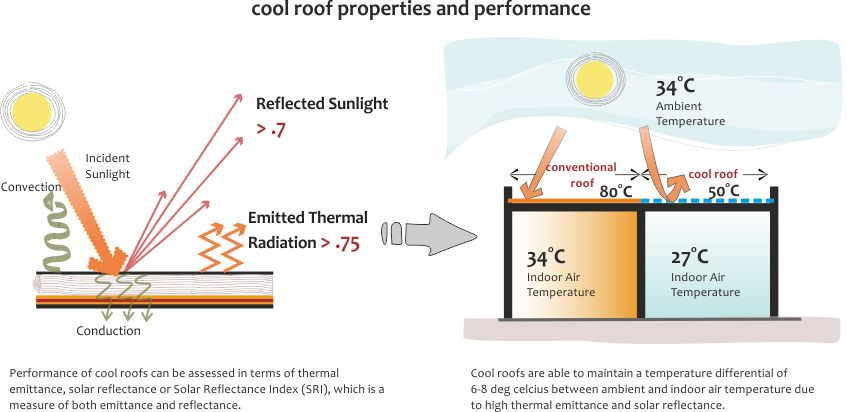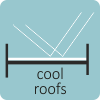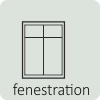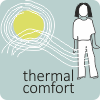Just as light-coloured clothing can help keep a person cool on a sunny day, cool roofs use solar-reflective surfaces to maintain lower roof temperatures. Highly reflective and light coloured roofs have now become an inclusive part of energy efficiency measure in a building. To achieve NZEB design goal, cool roofs can be used to reduce energy bills by decreasing air conditioning needs, improve indoor thermal comfort and decrease roof operating temperature. Traditional dark roofs reach temperatures of 66ºC (150ºF) or more in the summer sun, in contrast a cool roof under the same conditions could stay more than 28ºC (50°F) cooler.
Cool Roofs
- Climate is an important consideration when deciding a cool roof installation. Cool roofs achieve the greatest cooling savings in hot climates, but can increase energy costs in colder climates due to reduced beneficial wintertime heat gains.
- Roof coatings should include special chemicals that prevent mold or algae growth for a few years. In warm, moist locations, cool roof surfaces can be more susceptible to algae or mold growth than hot roofs.
- Proper design techniques should be used to avoid condensation, especially in cold climates. In cold climates, roofs can accumulate moisture through condensation, and it is possible that cool roofs might be more susceptible to accumulating moisture than dark roofs of the same design.
- Decision on cool roofs should be taken by keeping in mind both installation costs (material and labour) and ongoing maintenance costs (repair, recoating, and cleaning). However, in most cases they are considered inexpensive energy efficiency measure in buildings.
- Recommendations on cool roof materials includes use of well-graded broken pieces of glossy glazed tiles (broken china mosaic) ,modified bitumen with plastic and a layer of reinforced material, RCC roof topped with elastomeric cool roof coating or simply finished with broken white glazed tiles.
- Slate and tile products are available with solar-reflective surfaces that offer a wide range of cool colours. Additionally, the dense, earthen composition of slate and tile products provide increased thermal mass, yielding additional energy savings not realized through solar reflectance and thermal emittance measures alone.
- Concrete and clay tiles may be obtained in white, increasing the solar reflectance to about 70 percent (compared to 20-30 percent range for red tile).
- Additional measures like roof insulation, vegetative roofs, and solar panels can be used to inhibit the flow of heat from roof to conditioned space within a building.
Online Resources
- Levinson R, Akbari H. 2010. Potential benefits of cool roofs on commercial buildings: conserving energy, saving money, and reducing emission of greenhouse gases and air pollutants. Energy Efficiency. 3:53-109
- Cool roof fact sheet
- https://heatisland.lbl.gov/coolscience/cool-roofs
Publications
- “Cool roofs for cool Delhi”: Design Manual – BEE
Tools
- DOE calculator: http://web.ornl.gov/sci/roofs+walls/facts/CoolCalcPeak.htm
- EPA calculator: http://roofcalc.com
- The EPA lists thousands of ENERGY STAR approved cool roofing materials.
http://www.energystar.gov/index.cfm?%20c=roof_prods.pr_roof_products - http://coolroofs.org/
Studies show that in warm and hot climates cool roofs perform well in meeting energy efficiency, cost-effectiveness,
and sustainability.
- Cool Roofs reduce annual air conditioning energy use of a single story building by up to 15%.
- They cool interior spaces in buildings that do not have air conditioning, making occupants more comfortable.
- Reduce carbon emissions by lowering the need for fossil-fuel generated electricity to run air conditioners.
- Potentially slow global warming by cooling the atmosphere.
Disclaimer: This website is made possible by the support of the American People through the United States Agency for International Development (USAID). The contents of this website are the sole responsibility of Environmental Design Solutions and do not necessarily reflect the views of USAID or the United States Government.

















